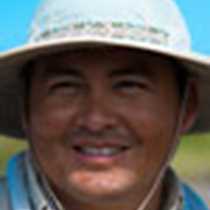Towering volcanos with scars due to successive lava flows that have occured in the last couple of centuries surrounded us today. Isabela Island, also known as Albemarle, is the largest island in the Galápagos with an area of 4,640 sq. km (1,790 sq. mi). Geologically speaking, the island is quite young and molded by the merger of six shield volcanoes about 600,000 years ago.
Isabela is rich in wildlife that has been threatened in the last couple of centuries due to introduced species. The island has been the focus of a significant and successful eradication program with the final goal of the ecological restoration of the islands. Thanks to these environmental programs, the flora and fauna of the island is recovering and our guests had a unique experience at Urbina Bay, which is at the base of Alcedo Volcano. Land iguanas that were under serious threat, especially from the exploding population of goats, were sighted every few yards during the walk. Lava lizards as well the popular Darwin’s finches and mockingbirds that inspired Charles Darwin in the development of the theory of evolution by means of natural selection delighted us with their characteristic sounds.
In the afternoon the National Geographic Endeavour lifted anchor to take us to our next destination, “Tagus Cove.” This historic bay of Tagus Cove was used a sheltered harbor for wayfarers over the centuries. Some interesting historic graffiti can be found near the landing, and many stories can be told of visitors to this protected cover. This area of Isabela is one of the places visited by Charles Darwin in 1835. The afternoon visit included different options such as deep-water snorkeling, kayaking, and Zodiac riding along the fascinating eroded coastline of Isabela. On each of the options we found Galápagos penguins, flightless cormorants, and other surprises that we didn’t expected during snorkeling such as sea horses and horn sharks. The strenuous but scenic hike up the rim of a tuff cone overlooking Darwin Lake and beyond was rewarded as well.
The relatively new volcanic fields and surrounding grounds have not developed the necessary nutrients required to support the wide-ranging of life zones found on older islands, but the flora and fauna of this place were beyond our expectations.




